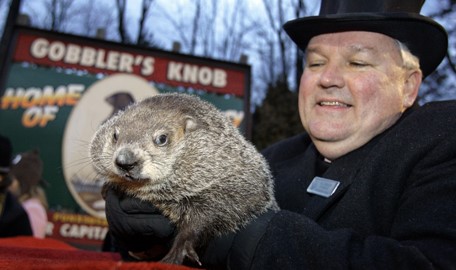On February 2, 1887, Punxsutawney, Pennsylvania, celebrated the first official Groundhog Day, a holiday with roots in ancient traditions.
The Origins of Groundhog Day
On February 2, residents of Punxsutawney, Pennsylvania, and other cities and towns across North America gather to observe a groundhog coming out of its den. If the groundhog sees its shadow, there will be six more weeks of winter; if the groundhog does not, spring will come early.
The tradition has its origins in ancient customs and a Christian feast day. Groundhog Day falls about midway between the winter solstice (December 21 or 22) and the vernal equinox (March 20 or 21). The midpoint between these events, known as a “cross-quarter day,” was a time for celebration in some ancient cultures. The Celts celebrated a holiday called Imbolc, according to Smithsonian Magazine.
The date of February 2 is derived from the Christian holiday Candlemas, also known as the Feast of the Purification of the Blessed Virgin, which is celebrated 40 days after December 25, the date honoring Christ’s birth.
In the medieval period, ancient beliefs about the weather were combined with the Candlemas celebration. An English song said, “If Candlemas be fair and bright, Come, Winter, have another flight; If Candlemas brings clouds and rain, Go Winter, and come not again.”
In Germany, the Teutons took note of when hibernating animals such as badgers and hedgehogs reappeared, which would signal that winter was nearing its end. This tradition would be integrated into the Candlemas celebration. German settlers brought the tradition to Pennsylvania.
Origins of Other Holidays
“They determined that the groundhog, resembling the European hedgehog, was a most intelligent and sensible animal and therefore decided that if the sun did appear on February 2nd, so wise an animal as the groundhog would see its shadow and hurry back into its underground home for another six weeks of winter,” according to the Punxsutawney Groundhog Club.
In 1886, the editor of The Punxsutawney Spirit wrote an article about people who went into the woods on Candlemas to observe groundhogs. The following year, the town made Groundhog Day an official holiday. Townspeople gathered around Gobbler’s Knob to watch a groundhog see his shadow, signaling another six weeks of winter.
Modern Groundhog Day Celebrations
Today, Groundhog Day traditions are observed from Georgia to Canada. The most famous celebration occurs in Punxsutawney, where the Inner Circle of the Punxsutawney Groundhog Club cares for the groundhog Punxsutawney Phil. The Punxsutawney Groundhog Club claims that Phil, who has also been known as Wiley William Woodchuck and Br’er Groundhog, is the same groundhog that made the prediction in 1887 thanks to “drinking the ‘elixir of life,’ a secret recipe.”
The Weather Channel has photos of 11 groundhogs to watch around the country, including Jimmy the Groundhog, Raleigh’s Sir Walter Wally, Dunkirk Dave and Staten Island Chuck.
PennLive has a video on YouTube of the 2016 Groundhog Day ceremony with Punxsutawney Phil.
Sources in this Story
- Smithsonian Magazine: A Short History of Groundhog Day
- Punxsutawney Groundhog Club: Groundhog Day History
- The Weather Channel: Groundhog Day 2015: Top 11 Groundhogs to Watch
- YouTube.com: Groundhog Day 2016: Watch Punxsutawney Phil’s Prediction
- The New York Times: Groundhog Almighty
Related Topic: “Groundhog Day” and Its Meaning
The 1993 film “Groundhog Day” brought considerable attention to the holiday, Punxsutawney, and Phil. According to the Punxsutawney Groundhog Club, the film attracted 30,000 or so people to Punxsutawney to see the groundhog in the years following the movie’s release.
In the movie, Bill Murray keeps reliving an unpleasant Groundhog Day until he is forced re-examine the way he treats the people around him. For some, the film has a deep meaning. It reflects many religious beliefs, such as Buddhism’s cycle of rebirth, Judaism’s emphasis on performing mitzvahs, and the Chinese religion Falun Gong’s concept of elevating oneself by learning from previous faults, according to the New York Times. Times film critic Michael Bronski even says, “The groundhog is clearly the resurrected Christ.”











